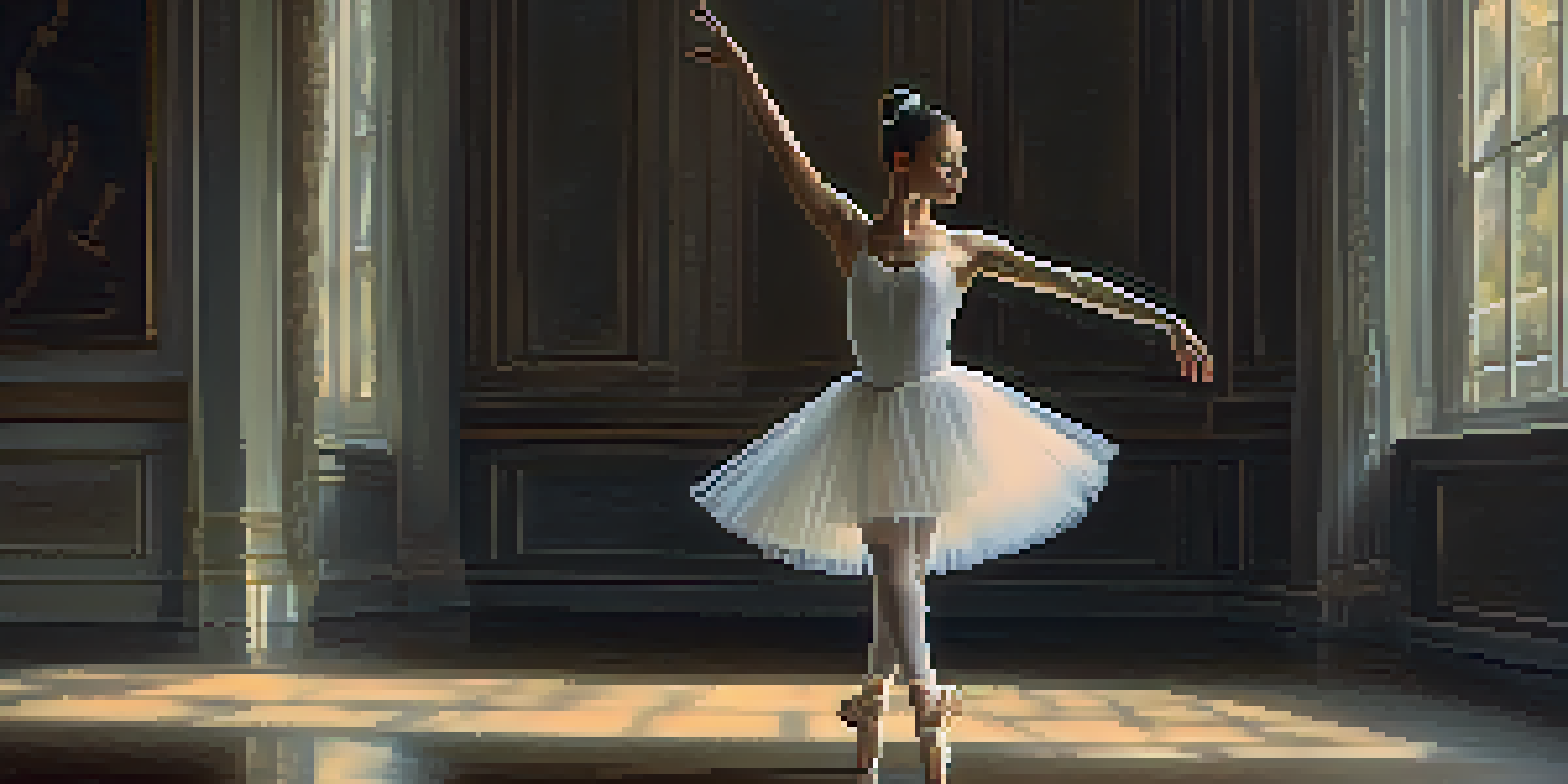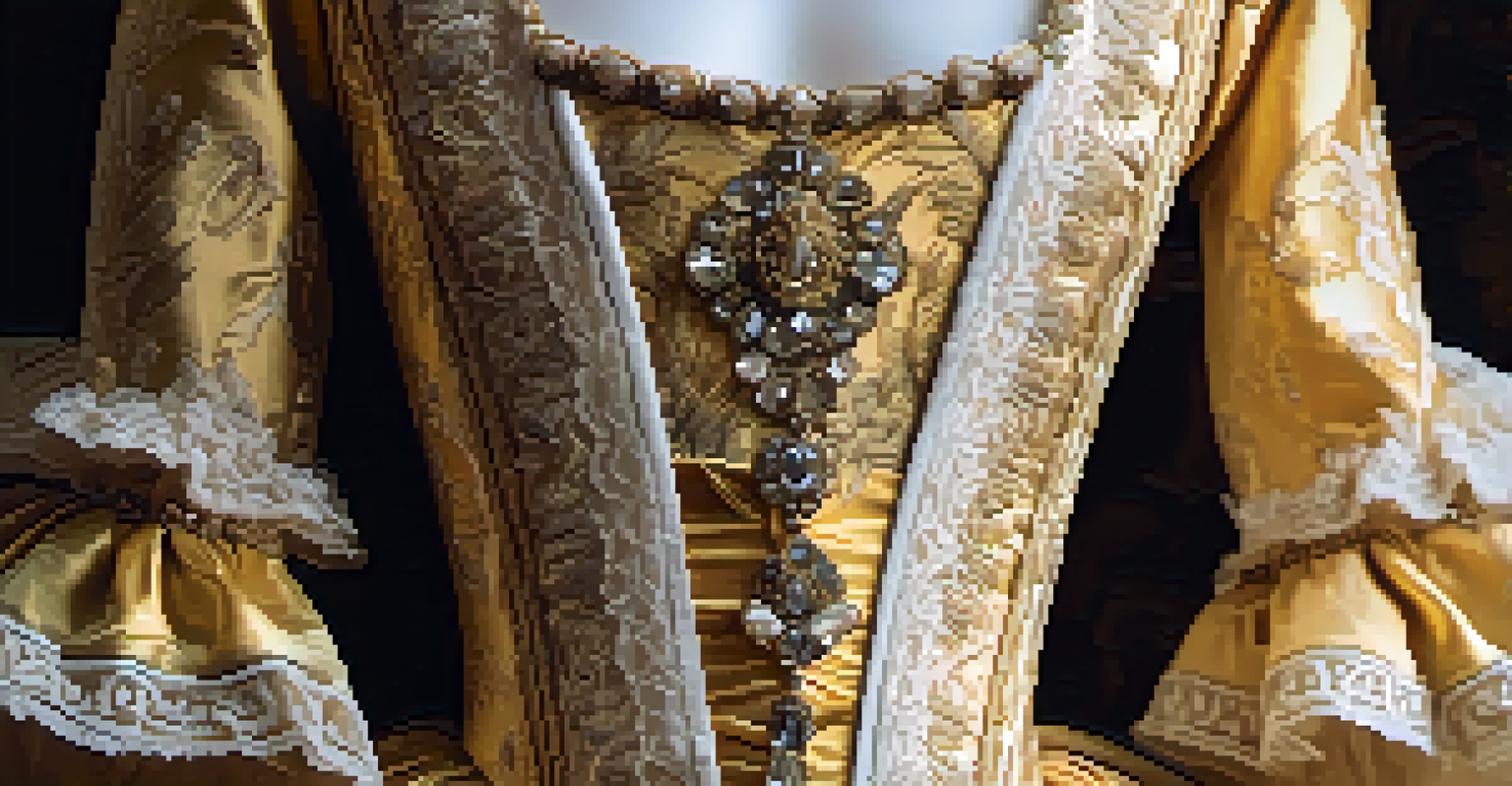Historical Analysis of Ballet Costumes Through the Ages

The Origins of Ballet Costumes in the Renaissance
Ballet costumes trace their roots back to the Renaissance, a time when dance was a vital expression of art and culture. Initially, dancers wore elaborate garments that reflected the fashion of the day, often adorned with jewels and intricate designs. These costumes were not just for show; they played a crucial role in conveying the character and emotion of the performance. As ballet began to formalize, the need for more functional attire became apparent, leading to the gradual shift in costume design.
Ballet is like a dream, and the costumes are the dreams we wear.
During this period, the emphasis was on opulence and grandeur, with skirts that were long and flowing, paired with bodices that accentuated the dancer's form. For example, the court ballets featured heavy fabrics that restricted movement, which contrasted sharply with today's emphasis on flexibility. The combination of aesthetics and practicality would continue to evolve as ballet gained popularity across Europe.
These early costumes laid the groundwork for the evolution of ballet attire, highlighting the delicate balance between artistry and functionality. The Renaissance period set the stage for future innovations, as costume designers began to understand the importance of allowing dancers to move freely while still looking stunning on stage.
The Baroque Era: Extravagance and Theatricality
The Baroque era marked a significant transformation in ballet costumes, characterized by extravagance and theatricality. Costumes became more elaborate, featuring ruffles, lace, and vibrant colors, reflecting the opulent lifestyles of the nobility. This period emphasized visual spectacle, with costumes designed to dazzle audiences and enhance the storytelling of performances. The influence of opera also began to seep into ballet, leading to even more intricate designs.

Dancers wore lavishly detailed outfits that often included heavy brocade fabrics and extravagant accessories like feathered headpieces. These embellishments not only served an aesthetic purpose but also aimed to convey the grandeur of the stories being told on stage. The use of color and texture became essential elements in creating a visually arresting performance, allowing dancers to embody their characters fully.
Ballet Costumes Evolve with Time
Ballet costumes have transformed from elaborate Renaissance garments to modern designs that prioritize freedom of movement and individual expression.
As ballet continued to evolve, the focus began to shift towards the dancer's movement and grace. While the Baroque era celebrated extravagance, it also set the stage for future minimalist styles that would prioritize agility, showcasing how the art form was already in constant flux.
The Classical Period: The Rise of the Romantic Style
The Classical period heralded a new era for ballet costumes, especially with the emergence of the Romantic style in the 19th century. This period saw a significant shift towards lighter fabrics and softer silhouettes, allowing for greater freedom of movement. Costumes became more ethereal, often featuring tulle and gauze, which created a dreamlike quality on stage. The iconic 'tutu' began to emerge during this time, symbolizing the grace and beauty of the ballerina.
Costume design is not just about fabric and color; it's about telling a story through visual art.
Romantic ballet emphasized themes of love, fantasy, and the supernatural, influencing costume design to reflect these ideas. Dancers often wore flowing skirts that allowed for dramatic movements, enhancing the storytelling aspect of performances. For instance, the famous ballet 'Giselle' showcased costumes that embodied both innocence and tragedy, further deepening the emotional connection with the audience.
This period marked a pivotal moment in ballet history, as the focus shifted from opulent decorations to the dancer's artistry. The lighter, more functional costumes not only allowed for intricate choreography but also contributed to the overall aesthetic of the performances, setting a new standard for future generations.
The 20th Century: Innovation and Expression
The 20th century brought about a wave of innovation in ballet costumes, driven by changing artistic movements and societal shifts. Designers began to experiment with new materials and styles, moving away from traditional norms. The introduction of modern dance influenced ballet, leading to a fusion of styles that embraced individuality and expression. Costumes became a canvas for creativity, allowing choreographers to visually convey their artistic vision.
Mid-century saw the rise of influential designers like Coco Chanel and Christian Dior, who created costumes that reflected contemporary fashion trends. This blending of ballet with fashion not only enhanced the visual appeal but also made ballet more accessible to a wider audience. Costumes during this era often incorporated elements of streetwear and other styles, breaking down barriers between high art and popular culture.
Cultural Influences Shape Designs
The blending of various cultural aesthetics in ballet costumes enriches the art form and reflects the diverse backgrounds of dancers and choreographers.
As ballet continued to evolve, so too did the emphasis on storytelling through costume design. The 20th century was a time of exploration, where the interplay between movement and attire became more pronounced. This era set the groundwork for the diverse range of ballet costumes we see today, highlighting the importance of innovation in the art form.
Contemporary Ballet: Blurring the Lines
In contemporary ballet, the lines between classical and modern dance have blurred, leading to a diverse range of costume styles. Designers are now embracing minimalism, with many opting for simple, form-fitting attire that allows for maximum movement. This shift reflects a broader trend in the dance world, where the focus is often on the dancer's physicality rather than elaborate costumes. The modern ballet aesthetic prioritizes the fluidity of movement, allowing the choreography to take center stage.
Additionally, contemporary ballet often incorporates multimedia elements, with costumes designed to interact with lighting and stage effects. This innovative approach enhances the overall experience, creating a dynamic visual narrative that complements the performance. For instance, costumes that change color or texture in response to lighting can evoke different emotions and enhance storytelling.
This era showcases how ballet has adapted to contemporary sensibilities, inviting a new generation of audiences to engage with the art form. The evolution of costumes reflects a broader cultural shift, emphasizing the importance of individual expression and creativity in ballet today.
The Role of Technology in Costume Design
Technology has played a crucial role in the evolution of ballet costumes, revolutionizing how they are designed and produced. Advances in fabric technology have led to the creation of lightweight, breathable materials that allow dancers to perform at their best. These innovations have made it possible to create costumes that are not only visually striking but also functional, enhancing the overall performance experience. For example, fabrics that wick away moisture keep dancers comfortable during intense performances.
Moreover, technology has enabled designers to experiment with 3D printing and digital design tools, leading to unique and intricate costume designs that were once unimaginable. This creative freedom allows for the incorporation of custom textures and patterns that add depth to the overall aesthetic. The use of technology in costume creation has opened up new avenues for artistic expression, pushing the boundaries of traditional design.
Technology Revolutionizes Costumes
Advancements in technology have led to innovative costume designs that enhance performance through functional and visually striking materials.
As we look to the future, the integration of technology in ballet costume design promises to further enhance the art form. By embracing innovation, designers can create costumes that not only captivate audiences but also support dancers' performance, ensuring that the beauty of ballet continues to evolve.
The Cultural Influence on Ballet Costumes
Cultural influences have always played a significant role in shaping ballet costumes, reflecting the diverse backgrounds of dancers and choreographers. As ballet has spread across the globe, various cultures have infused their traditions into costume design, leading to vibrant and unique interpretations. This melding of styles not only enriches the art form but also celebrates the global nature of ballet, showcasing how different cultures contribute to its evolution.
For example, in productions like 'The Nutcracker,' costumes often draw from various cultural elements, incorporating traditional motifs and colors that resonate with the story's themes. This blending of cultural aesthetics enhances the visual storytelling, allowing audiences to connect with the performance on a deeper level. The result is a rich tapestry of design that reflects the world we live in.

As ballet continues to diversify, the influence of culture on costume design will only grow stronger. This evolution highlights the importance of inclusivity in the art form, inviting new voices and perspectives to shape its future. By embracing cultural influences, ballet costumes can tell stories that resonate with audiences from all walks of life.